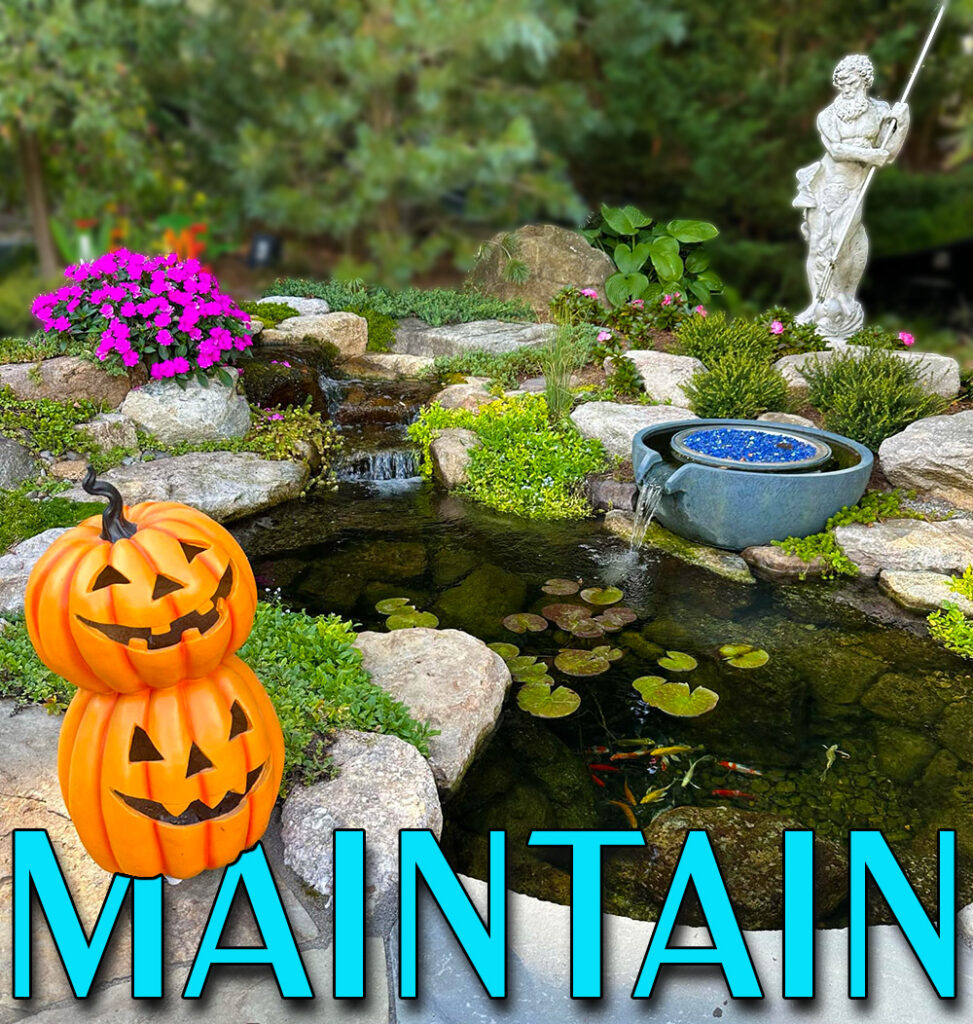
Fall is a critical time for keeping your New Jersey water feature in top condition. As leaves fall and temperatures drop, your pond, fountain, or waterfall requires special care to remain healthy and beautiful. So, how can you maintain your New Jersey water feature this fall? This detailed checklist will guide you through the essential steps to ensure your water feature thrives during the cooler months.
1. Clear Out Debris
The first step to maintain your New Jersey water feature this fall is to clear out debris. Leaves, twigs, and other organic matter can quickly accumulate, leading to clogged pumps and poor water quality. Use a net to skim the surface and remove as much debris as possible.
Consider installing a pond net or leaf netting over your water feature to catch falling leaves before they can sink and decompose. Regularly empty the net to prevent overflow and keep your water clean.
2. Prune and Trim Aquatic Plants
As part of your efforts to maintain your New Jersey water feature this fall, be sure to prune and trim your aquatic plants. Cut back any dead or dying foliage to prevent it from decomposing in the water, which can lead to an imbalance in your pond’s ecosystem.
For hardy plants, a light trim will encourage healthy growth come spring. If you have tropical or sensitive plants, consider moving them indoors or to a greenhouse to protect them from frost.
3. Adjusting Pump and Equipment Settings for Fall
As temperatures drop in New Jersey, it’s essential to adjust the settings on your pumps and other equipment to ensure your water feature continues to run efficiently throughout the fall.
Pump Settings:
- Reduce Flow Rate: As the weather cools, reducing the flow rate of your pump helps prevent excessive water movement that can cause splashing. This is especially important for fountains and waterfalls, where splashed water can freeze when temperatures drop.
- Timer Adjustments: Consider reducing the operating time of your pump. Running the pump for shorter periods during the day can save energy and reduce wear on your equipment as your water feature sees less use in cooler weather.
- Pump Removal (if necessary): In regions of New Jersey where freezing temperatures are common, it may be best to turn off and remove your pump altogether, particularly for smaller water features that are prone to freezing. Store the pump indoors to prevent ice damage.
Filtration System:
- Clean and Inspect: Fall is the perfect time to thoroughly clean your filter and inspect it for any clogs or damage. Ensure the filtration system is functioning efficiently before winter sets in.
- Reduce Filtration Power: Just like the pump, consider reducing the power of your filtration system. With lower biological activity in cooler weather, less filtration is required to maintain water clarity.
UV Clarifiers:
- Turn Off UV Clarifiers: If you use a UV clarifier to control algae, you can turn it off in the fall as algae growth typically slows down due to shorter daylight hours and cooler temperatures.
4. Inspect and Service Equipment
Fall is the ideal time to inspect and service your New Jersey water feature’s equipment. Pumps, filters, and skimmers should be cleaned and checked for any signs of wear or damage. If your water feature is in a region prone to freezing temperatures, you may need to remove and store your pump to prevent ice damage.
For fountains, waterfalls, or features with moving water, consider reducing the flow as temperatures drop. This helps minimize splashing and reduces the risk of ice forming on surfaces, which can cause damage.
5. Monitor Water Quality
Monitoring water quality is essential for keeping your water feature healthy as the weather changes. Test the water regularly to check pH levels, ammonia, and nitrate levels. Adjust as necessary to maintain a balanced environment for your plants and fish.
In addition to chemical balance, ensure that the water level is maintained. Evaporation and plant absorption can lower the water level, putting stress on your pump. Top off the water feature with fresh, dechlorinated water as needed.
6. Prepare Fish for Winter
If your water feature includes fish, fall is the time to prepare them for winter. As the water temperature drops, fish will become less active and require less food. Gradually reduce feeding as the temperature decreases, and switch to a high-protein, low-carb diet to help them build energy reserves for the winter.
Ensure that your pond is deep enough to prevent the water from freezing solid. A depth of at least 18 inches is typically sufficient. If needed, install a pond heater or de-icer to keep an area of the pond ice-free, allowing toxic gases to escape and oxygen to enter.
7. Plan for Winterization
The final step to maintain your New Jersey water feature this fall is planning for winterization. Depending on your climate, this might involve covering your feature, installing a heater, or even draining it completely.
Make a plan for how you’ll protect your water feature from freezing temperatures. For smaller features, consider draining and storing them indoors. For larger ponds or waterfalls, ensure that any necessary equipment like de-icers or heaters is in place before the first freeze.
Conclusion
Wondering how you can maintain your New Jersey water feature this fall? By following this detailed checklist—from clearing debris to planning for winterization—you can ensure that your pond, fountain, or waterfall stays in top condition throughout the cooler months.
Ready to enhance your New Jersey water feature this fall? Contact us at 973-627-0515 for expert planting advice and services tailored to your water garden needs!
For more content with tips, tricks and amazing water feature goodness, check us out on YouTube!